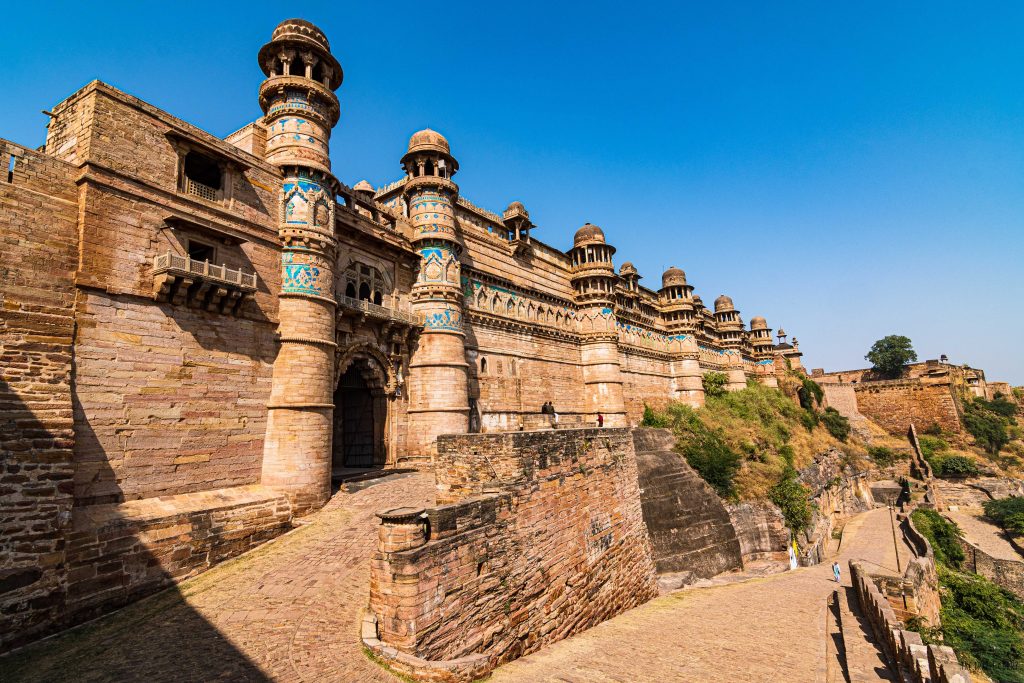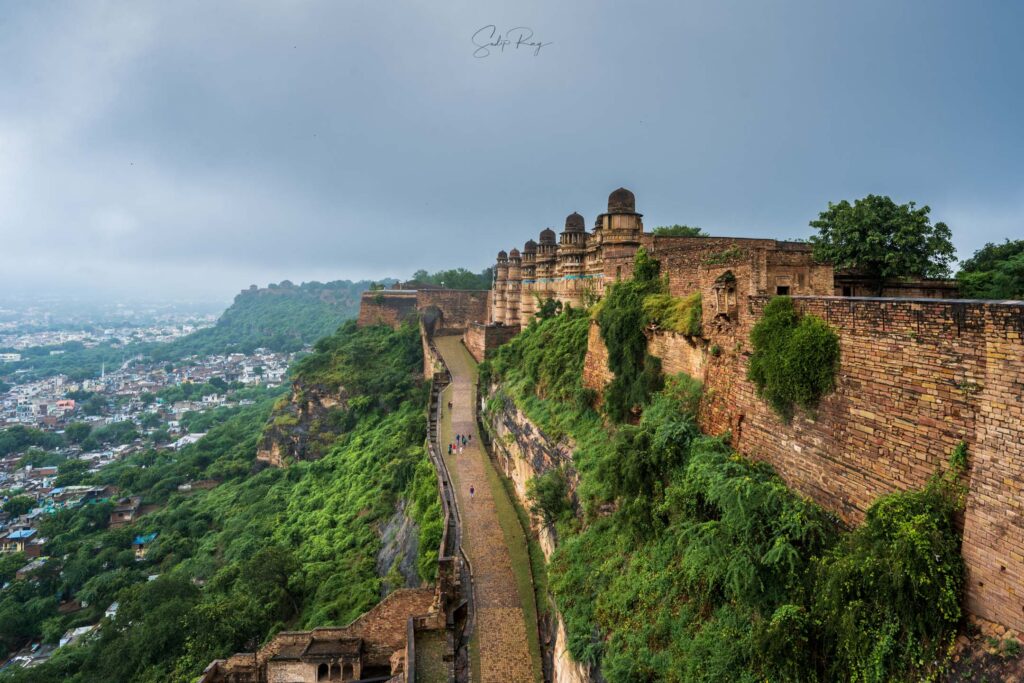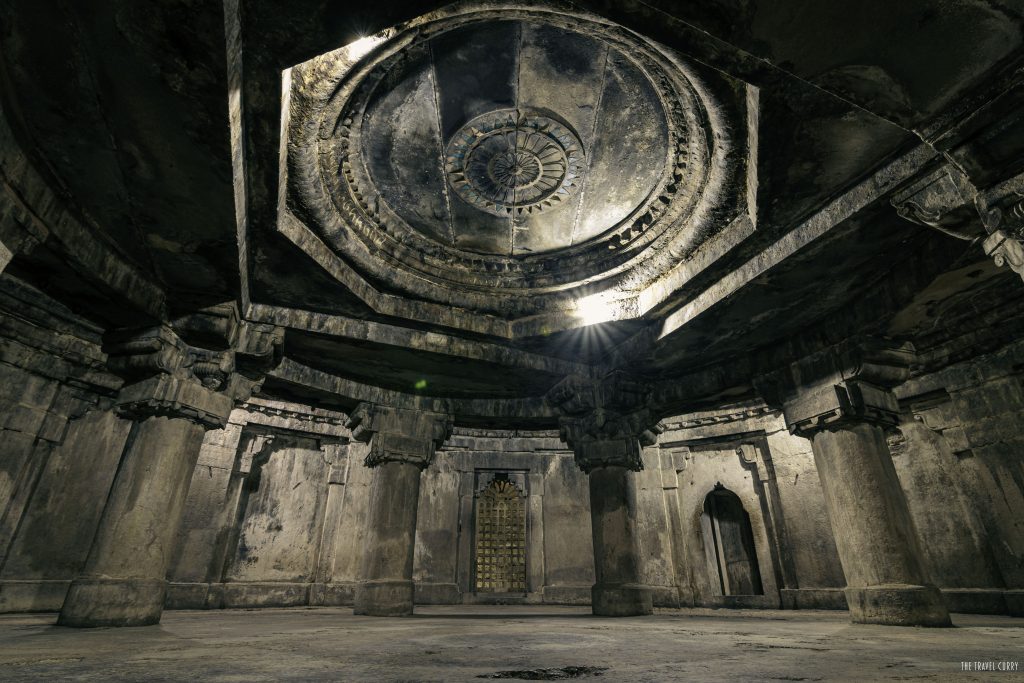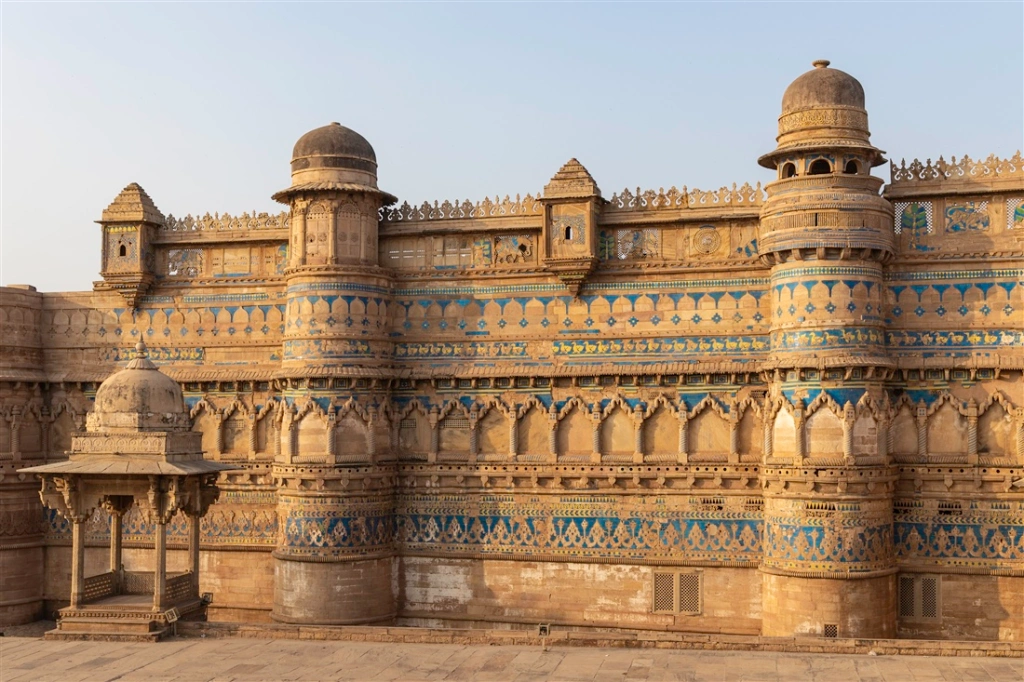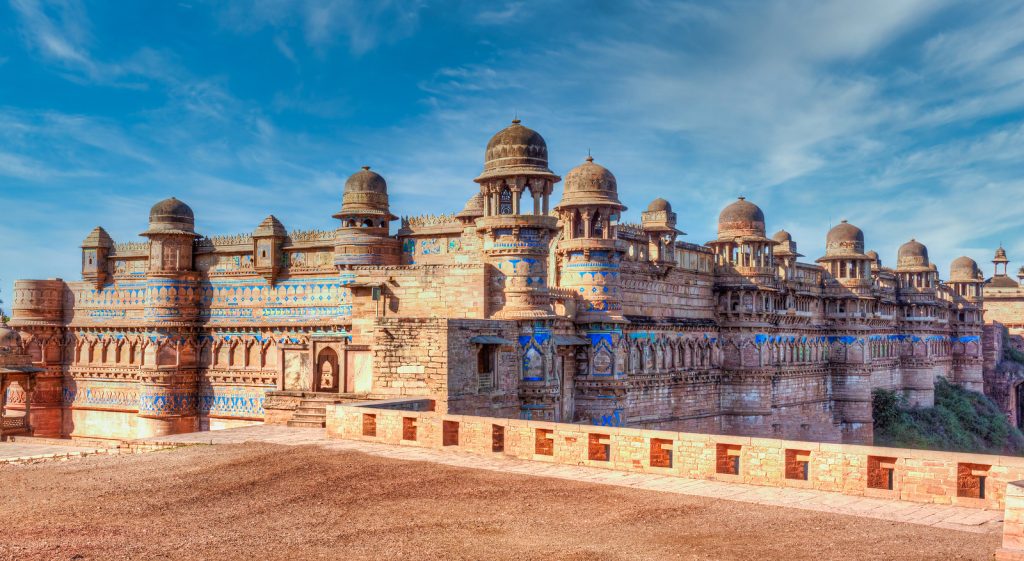Gwalior Fort is an 8th-century hill fort near Gwalior, Madhya Pradesh, central India. The fort consists of a defensive structure and two main palaces, Gujari Mahal and Man Mandir, built by Man Singh Tomar. The fort has been controlled by a number of different rulers in its history. The Gurjari Mahal palace was built for Queen Mrignayani. It is now an archaeological museum. The oldest record of “zero” in the world was found in a small temple, which is located on the way to the top. The inscription is around 1500 years old. The fort is built on an outcrop of Vindhyan sandstone on a solitary rocky hill called Gopachal. This feature is long, thin, and steep. The geology of the Gwalior range rock formations is ochre coloured sandstone covered with basalt. There is a horizontal stratum, 342 feet (104 m) at its highest point (length 1.5 miles (2.4 km) and average width 1,000 yards (910 m)). The stratum forms a near-perpendicular precipice. A small river, the Swarnrekha, flows close to the palace. The exact period of Gwalior Fort’s construction is not certain. According a local legend, the fort was built by a local king named Suraj Sen in 8 CE. He was cured of leprosy, when a sage named Gwalipa offered him the water from a sacred pond, which now lies within the fort. The grateful king constructed a fort, and named it after the sage. The sage bestowed the title Pal (“protector”) upon the king, and told him that the fort would remain in his family’s possession, as long as they bore this title. 83 descendants of Suraj Sen Pal controlled the fort, but the 84th, named Tej Karan, lost it. Historical records prove that the fort definitely existed in the 10th century. The inscriptions and monuments found at what is now the fort campus indicate that it may have existed as early as the beginning of the 6th century. A Gwalior inscription describes a sun temple built during the reign of the Huna emperor Mihirakula in 6th century. The Teli ka Mandir, now located within the fort, was built by the Gurjara-Pratiharas in the 9th century. The Kachchhapaghatas controlled the fort in 10th century, most probably as feudatories of the Chandelas. From 11th century onwards, the Muslim dynasties attacked the fort several times. In 1022 CE, Mahmud of Ghazni besieged the fort for four days. According to Tabaqat-i-Akbari, he lifted the siege after in return for a tribute of 35 elephants. The Ghurid general Qutb al-Din Aibak, who later became a ruler of the Delhi Sultanate, captured the fort in 1196 after a long siege. The Delhi Sultanate lost the fort for a short period, before it was recaptured by Iltumish in 1232 CE. In 1398, the fort came under the control of the Tomar Rajputs. The most distinguished of the Tomar rulers was Maan Singh, who commissioned several monuments within the fort. The Delhi Sultan Sikander Lodi tried to capture the fort in 1505, but was unsuccessful. Another attack, by his son Ibrahim Lodi in 1516, resulted in Maan Singh’s death. The Tomars ultimately surrendered the fort to the Delhi Sultanate after a year-long siege. Within a decade, the Mughal emperor Babur captured the fort from the Delhi Sultanate. The Mughals lost the fort to Sher Shah Suri in 1542, but Babur’s son Akbar recaptured it in 1558. Akbar made the fort a prison for political prisoners. For example, Kamran, Akbar’s cousin was held and executed at the fort. Aurangzeb’s brother, Murad and nephews Suleman and Sepher Shikoh were also executed at the fort. The killings took place in the Man Madir palace. After the death of the Mughal emperor Aurangzeb, the Rana chieftains of Gohad held the Gwalior Fort. The Maratha general Mahadaji Shinde (Scindia) captured the fort from the Gohad Rana Chhatar Singh, but soon lost it to the British East India Company. On August 3, 1780, a Company force under Captains Popham and Bruce captured the fort in a daring nighttime raid, scaling the walls with 12 grenadiers and 30 sepoys. Both sides suffered fewer than 20 wounded total. In 1780, the British governor Warren Hastings restored the fort to the Ranas of Gohad. The Marathas recaptured the fort four years later, and this time the British did not intervene because the Ranas of Gohad had become hostile to them. Daulat Rao Sindhia lost the fort to the British during the Second Anglo-Maratha War. There were frequent changes in the control of the fort between the Scindias and the British between 1808 and 1844. In January 1844, after the battle of Maharajpur, the fort was occupied by the Gwalior State of the Maratha Scindia family, as protectorate of the British government. During the 1857 uprising, around 6500 sepoys stationed at Gwalior rebelled against the Company rule, although the Company’s vassal ruler Jayaji Scindia remained loyal to the British. The British took control of the fort in June 1858. They rewarded Jayaji with some territory, but retained control of the Gwalior Fort. By 1886, the British were in complete control of India, and the fort no longer had any strategic importance to them. Therefore, they handed over the fort to the Scindia family. The Scindias continued to rule Gwalior until the independence of India in 1947, and built several monuments including the Jai Vilas Mahal. The fort and its premises are well maintained and house many historic monuments including palaces, temples and water tanks. There are also a number of palaces (mahal) including the Man mandir, the Gujari, the Jahangir, the Karan, and the Shah Jahan. The fort covers an area of 3 square kilometres (1.2 sq mi) and rises 35 feet (11 m). Its rampart is built around the edge of the hill, connected by six bastions or towers. The profile of the fort has an irregular appearance due to the undulating ground beneath. There are two gates; one on the northeast side with a long access ramp and the other on the southwest. The main entrance is the ornate Elephant gate (Hathi Pul). The other is the Badalgarh Gate. The Man Mandir palace or citadel is located at the northeast end of the fort. It was built in the 15th century and refurbished in 1648. The water tanks or reservoirs of the fort could provide water to a 15,000 strong garrison, the number required to secure the fort.
Gallery
